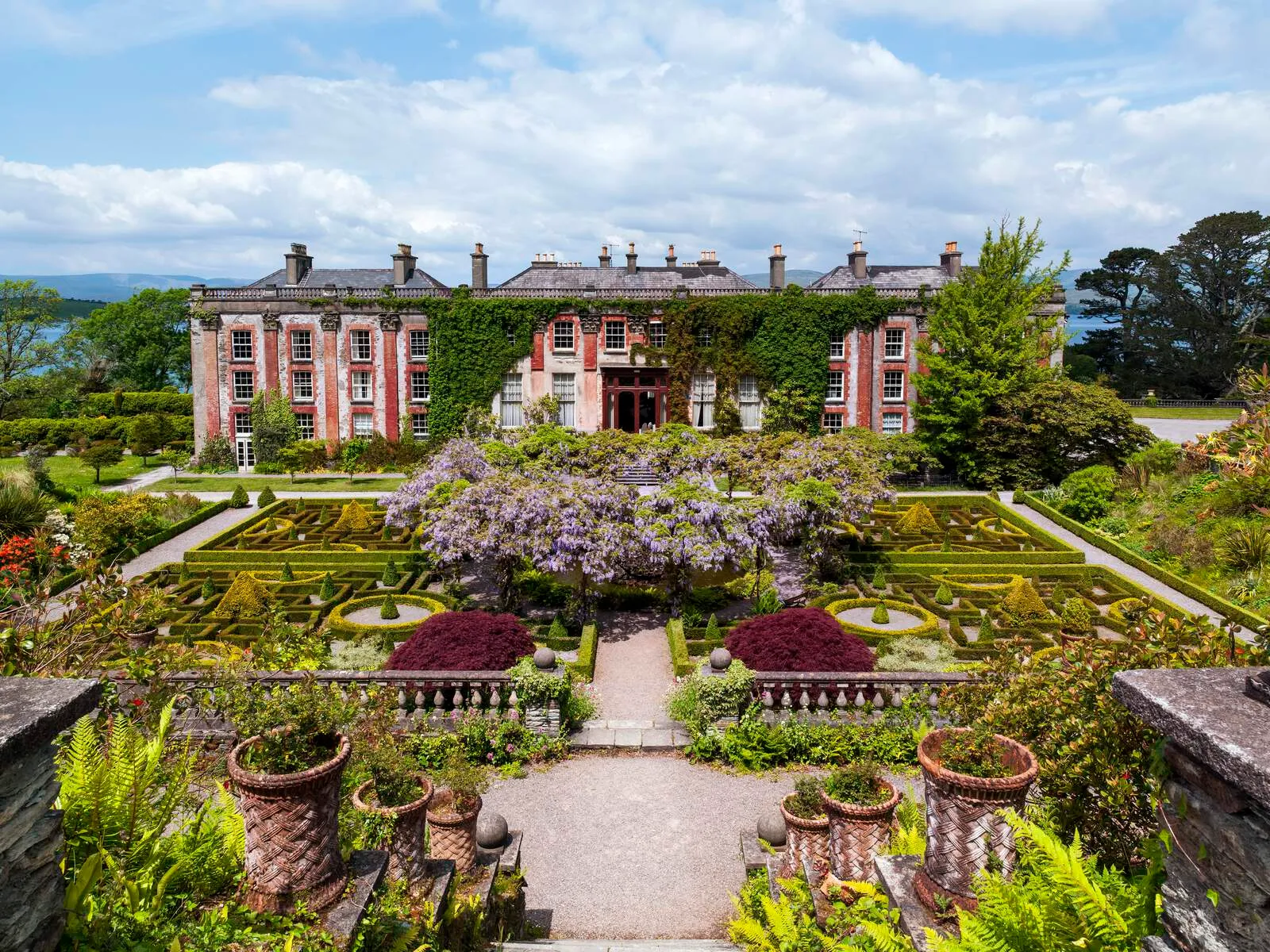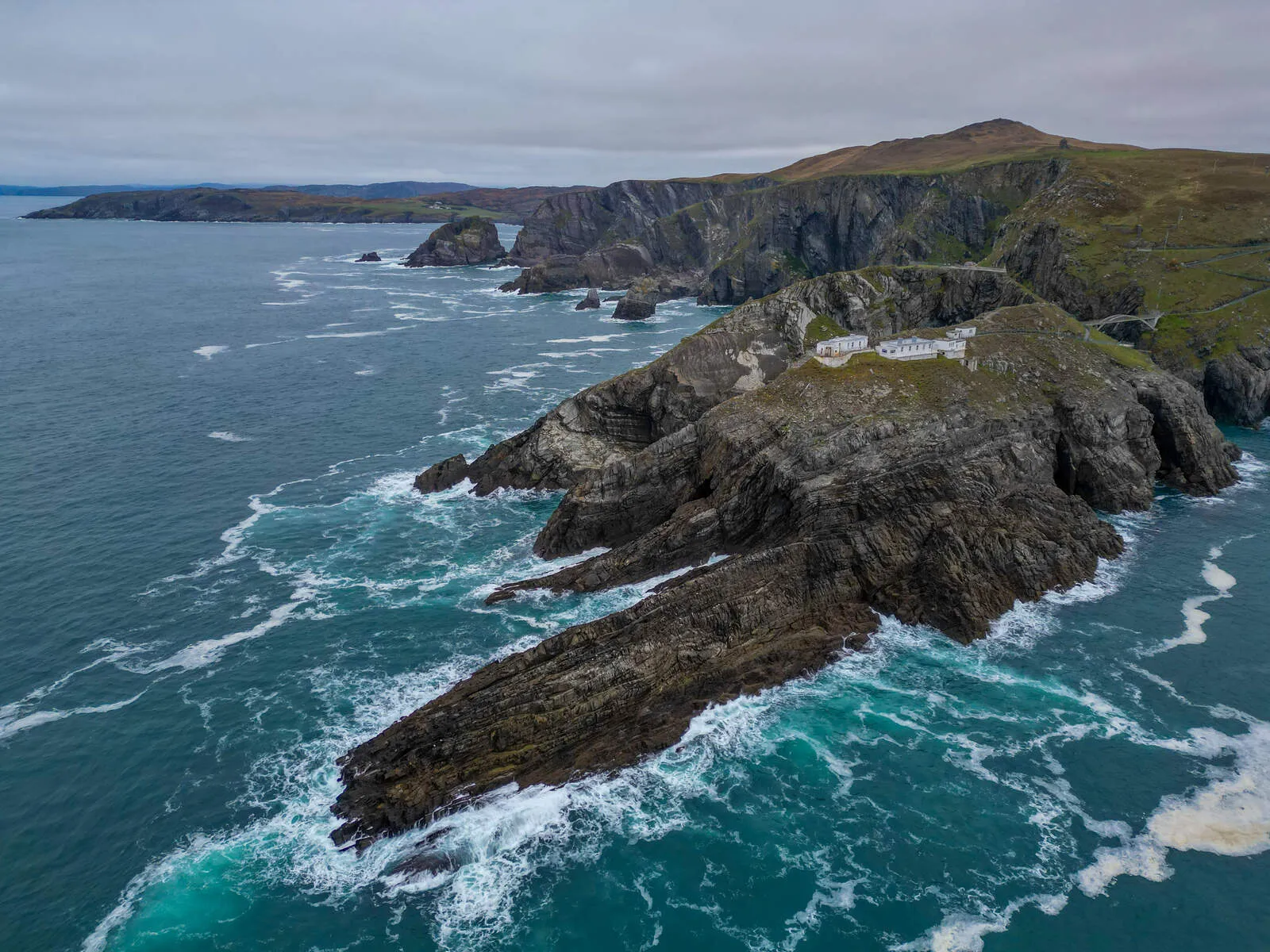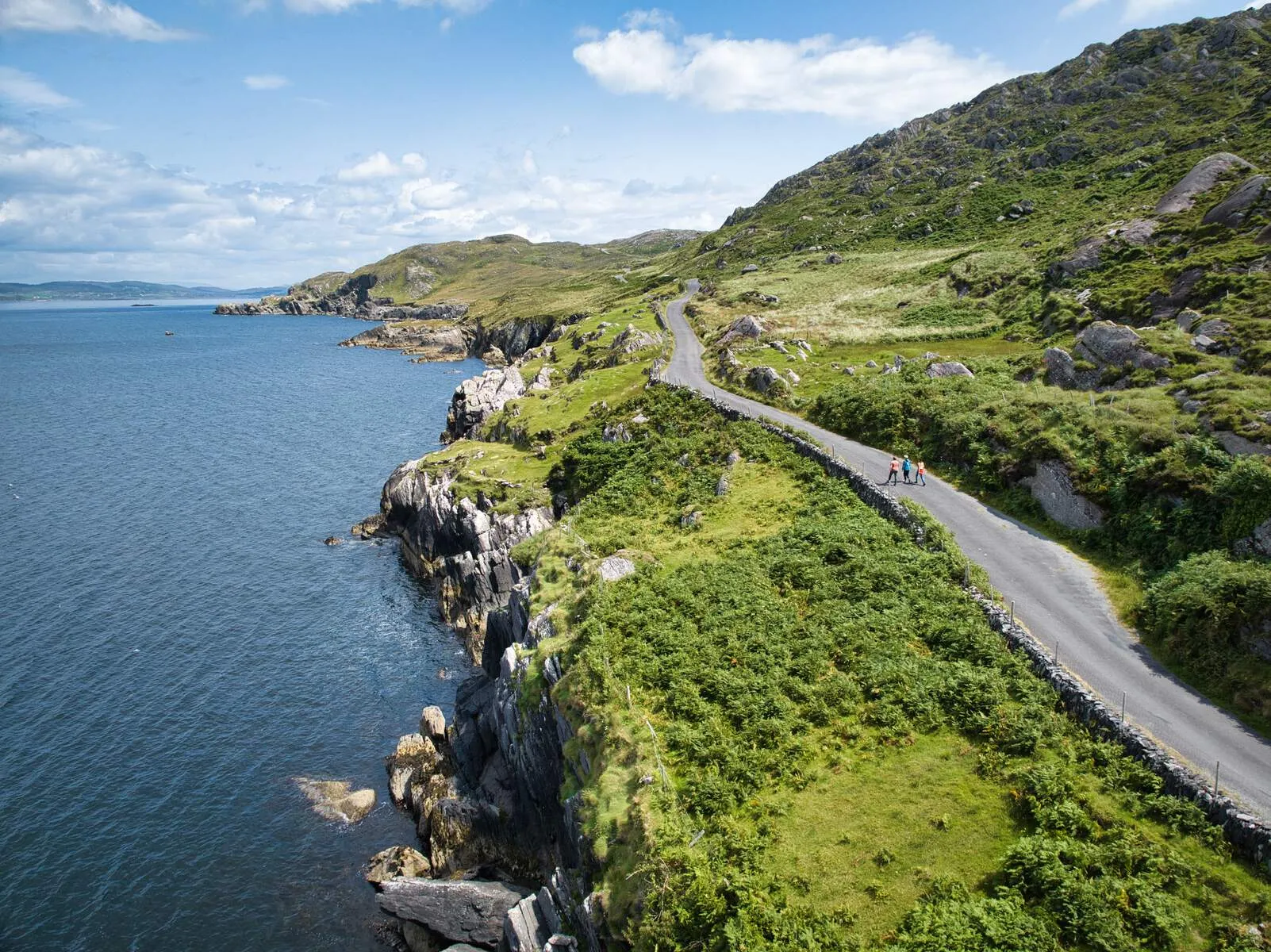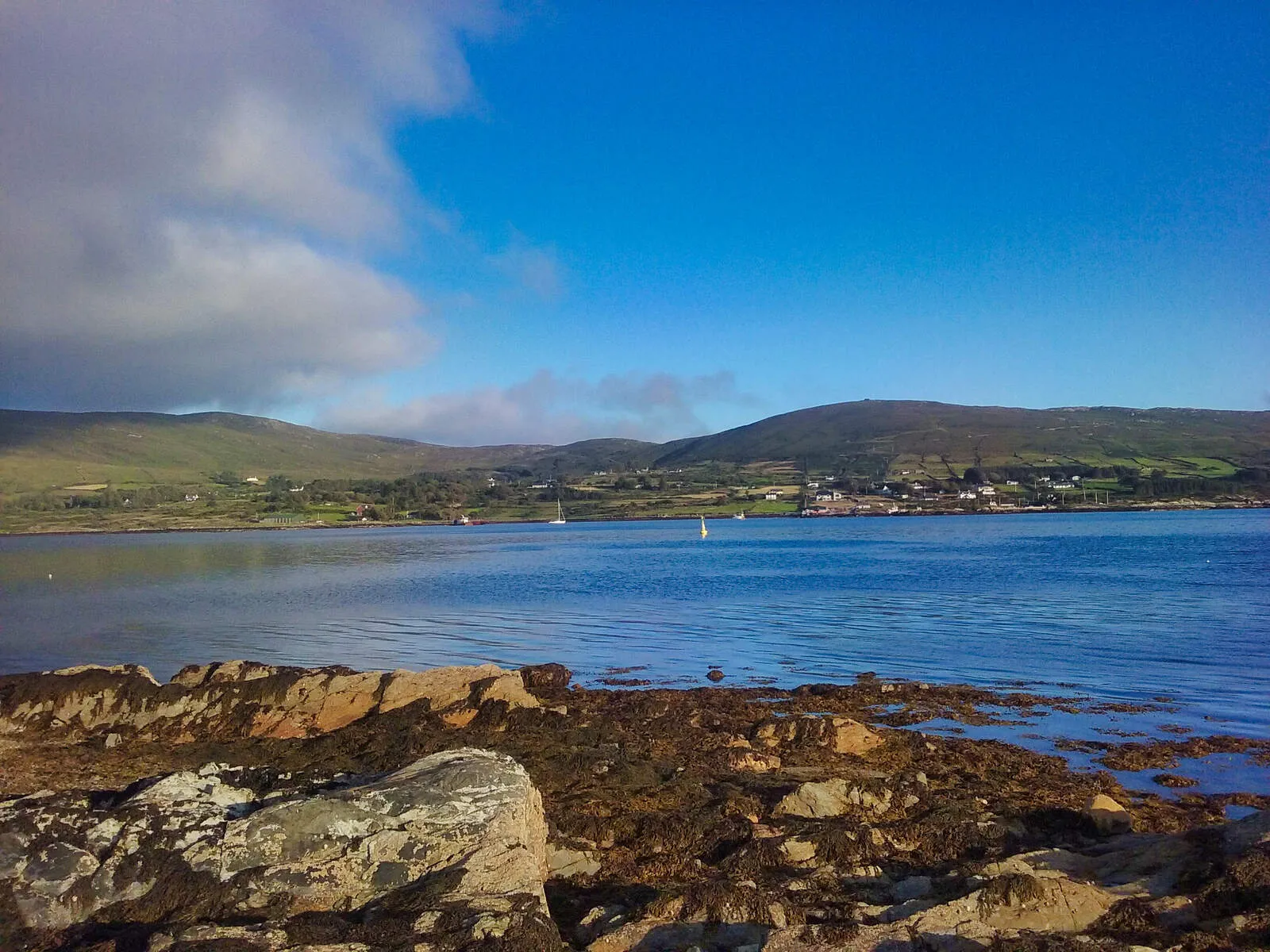Bantry's deep-water harbor cradles a town where history whispers through cobblestone streets and the Atlantic's salt-kissed breeze carries tales of ancient seafarers. Nestled at the head of Bantry Bay - one of Europe's safest natural harbors - the town thrives as a cosmopolitan hub in Ireland's rugged West Cork, bookended by three dramatic peninsulas along the Wild Atlantic Way. Here, stately Georgian architecture like Bantry House & Gardens (home to tapestries and panoramic views) shares space with vibrant markets brimming with local produce and artisan crafts. Step into 1796 at the French Armada Exhibition Centre, where Wolfe Tone's failed invasion left echoes, or wander Kilnaruane Pillar Stone, a carved ancient monument hinting at the island's earliest settlers. By day, Bantry's community spirit blooms in weekly markets; by night, its pubs hum with traditional music that's been played here for generations.
For adventurers, this is where land and sea collide in exhilarating harmony. Paddle along the Bantry Bay Blueway Trail, gliding past Garnish Island's tropical gardens - a kaleidoscope of subtropical blooms clinging to cliffs - as seals bob alongside your kayak. By midsummer, the West Cork Chamber Music Festival spills into cobbled squares, while autumn brings literary luminaries to readings by crackling fires. Just beyond town, Whiddy Island ferry tours reveal Napoleonic-era gun batteries and serene loughs, while Mizen Head's cliffs guard secrets of Ireland's wild southwest. Whether chasing waterfalls on the Beara Peninsula or savoring mussels fresh from Bantry Bay, this is a place where every horizon invites exploration - and every local has a story to share over a pint.
Jump to section:
Things to See and Do

Bantry House & Gardens
A Georgian mansion surrounded by 18th-century gardens. Features a notable art collection and hosts cultural events including the West Cork Chamber Music Festival.

Garinish Island
A subtropical garden on an island in Bantry Bay with vibrant flowers, waterfalls, and a Victorian-era castle ruin. Accessible by ferry from Glengarriff.

Whiddy Island Ferry & History Tour
Explore this historical island with Napoleonic-era gun batteries and ruins of the 1920s oil terminal. Includes ferry access from Bantry Port.

Mizen Head
Ireland's most southerly point with stunning coastal views and exhibits on geology, weather patterns, and the Fastnet Lighthouse.
Sheep's Head Way Walks
A 134km coastal walking route with dramatic cliffs and villages like Berehaven. Offers guided tours and self-guided itineraries.

Beara Peninsula Scenic Drive
A 150km driving route featuring the Atlantic coastline, waterfalls like Gleninchaquin, and historical sites including Allihies Copper Mines.

Gougane Barra Lakes & Monastery
A tranquil valley with a lake surrounded by mountains, home to St. Finbarr's early Christian oratory and outdoor concerts.

Bere Island Whale & Dolphin Watching
Guided boat tours departing from Bere Island to observe marine life such as humpback whales and Risso's dolphins.
Bantry Bay Kayaking Blueway Trail
A designated water trail through Bantry Bay, offering kayaking access to islands like Garnish and Keeragh. Rentals available locally.
French Armada Exhibition (Bantry House)
Housed within Bantry House, this exhibit details the 1796 French invasion attempt linked to Wolfe Tone's rebellion plans.
Bantry Market & Farmers' Fair
Weekly Friday market (summer months) featuring artisanal foods, local crafts, and antiques in Bantry town center.
Kilnaruane Pillar Stone
1st-century AD carved stone monument depicting a boat with oarsmen near Bantry. Part of Ireland's Ancient East heritage.
Carriganass Castle Ruins
A 16th-century tower house near Kealkil, linked to the MacCarthy Mór dynasty and offering views of Kenmare Bay.
Bantry Museum & Heritage Centre
Housed in a restored courthouse, this museum features local history exhibits including maritime artifacts (limited seasonal hours).
Allihies Copper Mines Trail
Historical mining ruins near Beara Peninsula showcasing 19th-century extraction techniques with guided tours available.
Getting There
Air
-
Cork Airport is approximately 1 hour 20 minutes drive from Bantry
-
Kerry Airport is approximately 1 hour 30 minutes drive from Bantry
-
Shannon Airport is located approximately 2 hours 40 minutes from Bantry on the N20
-
Dublin Airport is located approximately 4 hours drive from Bantry via the M8
Rail
No rail services are available to Bantry, as the town's railway station closed in 1961
Bus
-
Bus Éireann operates scheduled bus services connecting Bantry town with:
-
Cork city
-
Glengarriff
-
Killarney
-
Castletownbere
-
Nearby towns and villages
-
Visit www.buseireann.ie for more information
-
Bus route 236 from Parnell Place bus station in Cork city is also available
Car
-
Bantry is accessed by the N71 national secondary road
-
Approximately 1 hour 20 minutes drive from Cork City
-
Approximately 85 km west of Cork city on the N71
-
Alternative scenic route via the Wild Atlantic Way, approximately 200 km from Cork Airport and Cork City
Ferry
-
Cork Port (Ringaskiddy) is located approximately 1 hour 30 minutes drive from Bantry and offers weekly sailings to Roscoff in France or Santander in Spain
-
Visit www.brittanyferries.ie for timetables and more information
-
Rosslare Port is approximately 3 hours 40 minutes drive from Bantry and offers routes to the UK and mainland Europe
-
A ferry service from Bantry pier to Whiddy Island is available, taking approximately 10-15 minutes
Events & Festivals 2025
There are currently no events listed. If you would like to add an event, please contact us.
History
Bantry's history stretches back centuries, with the area first settled in ancient times. The town is said to have been founded by Saint Breandán, also known as Brendan the Navigator, who according to Irish lore was the first person to discover America. Archaeological evidence, including stone circles and megalithic tombs, attests to the presence of early inhabitants in the area.
In the 17th century, Bantry was a small settlement, described by Jacobite army officer John Stevens as "a miserable poor place" consisting of just a few houses and cottages. However, its strategic location on Bantry Bay made it an attractive spot for merchants and fishermen. The White family, who would later become prominent in the area's history, arrived in Bantry in the late 17th century, having originally been merchants in Limerick.
The French expedition to Ireland in 1796 marked a significant turning point in Bantry's history. Led by Admiral Hoche, the armada aimed to support the United Irishmen's rebellion against British rule. Although the invasion ultimately failed due to severe weather conditions, Richard White, owner of Bantry House, played a key role in preparing the local defenses and was later rewarded with a peerage.
Throughout the 18th and 19th centuries, Bantry continued to grow as a commercial center, with the town's harbor becoming an important hub for fishing and trade. The construction of Bantry House, which began in the early 18th century, reflected the increasing prosperity of the White family, who would go on to become Earls of Bantry.
The Irish War of Independence and subsequent Civil War had a significant impact on Bantry, with the town experiencing violent clashes between British forces and Irish rebels. Bantry House itself was used as a temporary base for British troops and later as a hospital during the conflict.
In more recent times, Bantry has experienced significant economic challenges, including the decline of its fishing industry and the devastating effects of the Whiddy Island disaster in 1979, which resulted in the loss of 42 lives. However, the town has also undergone regeneration efforts, with the restoration of Bantry House and the development of tourism initiatives aiming to showcase the area's rich history and natural beauty.
Today, visitors can explore Bantry's fascinating past by visiting historic sites such as Bantry House, the French Armada Centre, and the Kilnaruane Pillar Stone. The town's museum, located behind the fire station, offers a glimpse into its social and cultural heritage, with exhibits featuring artifacts from the area's history, including the famous West Cork Hooded Cloak.